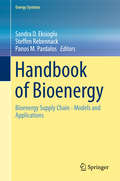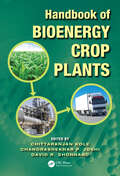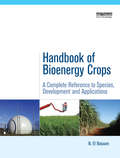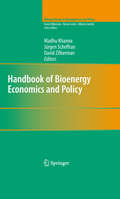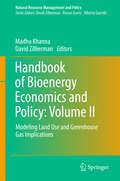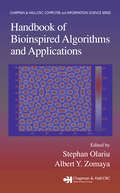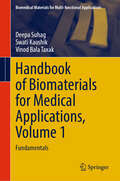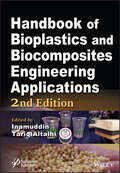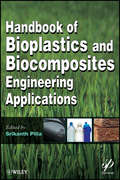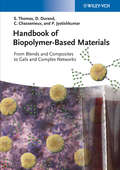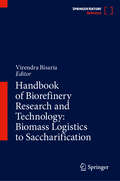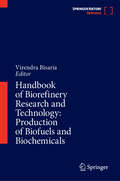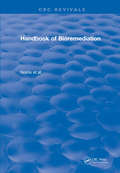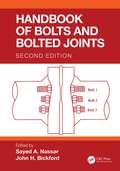- Table View
- List View
Handbook of Bioelectronics
by Sandro Carrara Krzysztof IniewskiThis wide-ranging summary of bioelectronics provides the state of the art in electronics integrated and interfaced with biological systems in one single book. It is a perfect reference for those involved in developing future distributed diagnostic devices, from smart bio-phones that will monitor our health status to new electronic devices serving our bodies and embedded in our clothes or under our skin. All chapters are written by pioneers and authorities in the key branches of bioelectronics and provide examples of real-word applications and step-by-step design details. Through expert guidance, you will learn how to design complex circuits whilst cutting design time and cost and avoiding mistakes, misunderstandings, and pitfalls. An exhaustive set of recently developed devices is also covered, providing the implementation details and inspiration for innovating new solutions and devices. This all-inclusive reference is ideal for researchers in electronics, bio/nanotechnology, and applied physics, as well as circuit and system-level designers in industry.
Handbook of Bioenergy
by Panos M. Pardalos Steffen Rebennack Sandra D. EksiogluThis handbook brings together recent advances in the areas of supply chain optimization, supply chain management, and life-cycle cost analysis of bioenergy. These topics are important for the development and long-term sustainability of the bioenergy industry. The increasing interest in bioenergy has been motivated by its potential to become a key future energy source. The opportunities and challenges that this industry has been facing have been the motivation for a number of optimization-related works on bioenergy. Practitioners and academicians agree that the two major barriers of further investments in this industry are biomass supply uncertainty and costs. The goal of this handbook is to present several cutting-edge developments and tools to help the industry overcome these supply chain and economic challenges. Case studies highlighting the problems faced by investors in the US and Europe illustrate the impact of certain tools in making bioenergy an economically viable energy option.
Handbook of Bioenergy Crop Plants
by Chittaranjan Kole Chandrashekhar P. Joshi David R. ShonnardAs the world's population is projected to reach 10 billion or more by 2100, devastating fossil fuel shortages loom in the future unless more renewable alternatives to energy are developed. Bioenergy, in the form of cellulosic biomass, starch, sugar, and oils from crop plants, has emerged as one of the cheaper, cleaner, and environmentally sustainab
Handbook of Bioenergy Crops: A Complete Reference to Species, Development and Applications (Routledge Studies in Bioenergy)
by N. El BassamBiomass currently accounts for about fifteen per cent of global primary energy consumption and is playing an increasingly important role in the face of climate change, energy and food security concerns. Handbook of Bioenergy Crops is a unique reference and guide, with extensive coverage of more than eighty of the main bioenergy crop species. For each it gives a brief description, outlines the ecological requirements, methods of propagation, crop management, rotation and production, harvesting, handling and storage, processing and utilization, then finishes with selected references. This is accompanied by detailed guides to biomass accumulation, harvesting, transportation and storage, as well as conversion technologies for biofuels and an examination of the environmental impact and economic and social dimensions, including prospects for renewable energy. This is an indispensable resource for all those involved in biomass production, utilization and research.
Handbook of Bioenergy Economics and Policy
by David Zilberman Madhu Khanna Jürgen ScheffranConcerns about energy security, uncertainty about oil prices, declining oil reserves, and global climate change are fueling a shift towards bioenergy as a renewable alternative to fossil fuels. Public policies and private investments around the globe are aiming to increase local capacity to produce biofuels. A key constraint to the expansion of biofuel production is the limited amount of land available to meet the needs for fuel, feed, and food in the coming decades. Large-scale biofuel production raises concerns about food versus fuel tradeoffs, about demands for natural resources such as water, and about potential impacts on environmental quality. The book is organized into five parts. The introductory part provides a context for the emerging economic and policy challenges related to bioenergy and the motivations for biofuels as an energy source. The second part of the handbook includes chapters that examine the implications of expanded production of first generation biofuels for the allocation of land between food and fuel and for food/feed prices and trade in biofuels as well as the potential for technology improvements to mitigate the food vs. fuel competition for land. Chapters in the third part examine the infrastructural and logistical challenges posed by large scale biofuel production and the factors that will influence the location of biorefineries and the mix of feedstocks they use. The fourth part includes chapters that examine the environmental implications of biofuels, their implications for the design of policies and the unintended environmental consequences of existing biofuel policies. The final part presents economic analysis of the market, social welfare, and distributional effects of biofuel policies.
Handbook of Bioenergy Economics and Policy: Volume II
by David Zilberman Madhu KhannaIn its second volume, this book aims to link the academic research with development in the real world and provide a historical and institutional background that can enrich more formal research. The first section will include an assessment of the evolution and the state of the nascent second-generation biofuel as well as a perspective on the evolution of corn ethanol and sugarcane ethanol in Brazil. It will also include a historical and institutional background on the biofuel industry in Brazil that has global lessons, and later, provide a technical overview of major analytical tools used to assess the economic, land use and greenhouse gas implications of biofuel policies at a regional and global level. Additionally, the book analyzes the various drivers for land use change both at a micro-economic level and at a macro-economic level. It presents studies that apply regional and global economic models to examine the effects of biofuel policies in the US, EU and Brazil on regional and global land use, on food and fuel prices and greenhouse gas emissions. These papers illustrate the use of partial and general equilibrium modeling approaches to simulate the effects of various biofuel policies, and includes studies showing the effects of risk aversion, time preferences and liquidity constraints on farmers decision to grow energy crops for biofuel production. By presenting the tools of lifecycle analysis for assessing the direct greenhouse gas intensity of biofuels, this handbook investigates the types of indirect or market mediated effects that can offset or strengthen these direct effects. It will include tools to assess the direct and indirect effects of biofuel production on greenhouse gas emissions in the US and Brazil, and ultimately provide a comprehensive background to understand the state of biofuel in the present and how to analyze their implication.
Handbook of Bioethical Decisions. Volume I: Decisions at the Bench (Collaborative Bioethics #2)
by Erick Valdés Juan Alberto LecarosThe Handbook of Bioethical Decisions is aimed at addressing and analyzing the most important ethical concerns and moral quandaries arisen in biomedical and scientific research. As such, it identifies and problematizes on a comprehensive range of ethical issues researchers must deal with in different critical contexts. Thus, the Handbook, Vol. I, may be helpful for them to make decisions and deliberate in complex practical scenarios. In this fashion, the volume reunites different points of view to give readers room enough to get a better knowledge and take their own position on pressing bioethical issues of the day. Consequently, this work seeks to engender dense ethical epistemology scientists can count on when conducting latest generation biomedical research. By bringing together an impressive array of contributions on the most important elements and categories for “at the bench” bioethical decisions as well as offering chapters by some of the most world renowned and prominent experts in bioethics, the Handbook, Vol. I, is a paradigmatic text in its area and a valuable resource for courses on bioethics, and biomedical research, as well as courses that discuss ethics and the biosciences at different professional levels, biomedical industry, pharmacological companies and the public sphere in general.
Handbook of Bioinspired Algorithms and Applications
by Albert Y. Zomaya Stephan OlariuThe mystique of biologically inspired (or bioinspired) paradigms is their ability to describe and solve complex relationships from intrinsically very simple initial conditions and with little or no knowledge of the search space. Edited by two prominent, well-respected researchers, the Handbook of Bioinspired Algorithms and Applications reveals the
Handbook of Biomass
by Sabu Thomas Cintil Jose Chirayil Mahesh Hosur Daniel PasquiniThis handbook constitutes state-of-the-art research covering topics such as chemical constituents of biomass, their specific properties, characterization and different applications. The contents also discuss challenges and issues involved in its applications. This volume brings together a number of biomass-derived potential renewable elements and its circular economy approach in one place. The content includes industrial applications and fills the gap in laboratory research works to practical applications in related industries. The book gives an insight towards the circular economy approach by the biomass, different gross morphologies of biomasses and the valuable chemical constituents that can be derived from the biomass and moreover the potential applications of all those constituents. It enables researchers and scientists to get informed of the designs to improve existing utilization of biomass in an efficient manner and deliver better products at lower cost.The volume isuseful reference for professionals, researchers, industrial practitioners, graduate students and senior undergraduates in the fields of polymer science, bioscience and bioengineering. It also provides an in-depth reference for biomass processors and fabricators and for industry sectors utilizing biomass such as packaging, sensors, film manufacturers, medical device manufacturers and biomedical engineers.
Handbook of Biomaterial Properties
by Jonathan Black William Murphy Garth HastingsThis book provides tabular and text data relating to normal and diseased tissue materials and materials used in medical devices. Comprehensive and practical for students, researchers, engineers, and practicing physicians who use implants, this book considers the materials aspects of both implantable materials and natural tissues and fluids. Examples of materials and topics covered include titanium, elastomers, degradable biomaterials, composites, scaffold materials for tissue engineering, dental implants, sterilization effects on material properties, metallic alloys, and much more. Each chapter author considers the intrinsic and interactive properties of biomaterials, as well as their appropriate applications and historical contexts. Now in an updated second edition, this book also contains two new chapters on the cornea and on vocal folds, as well as updated insights, data, and citations for several chapters.
Handbook of Biomaterials for Medical Applications, Volume 1: Fundamentals (Biomedical Materials for Multi-functional Applications)
by Deepa Suhag Swati Kaushik Vinod Bala Taxak"Handbook on Biomaterials for Medical Applications: Fundamentals" is a critical monograph that merges advanced technological insights with practical applications in biomedical materials science. It navigates through the intricate blend of theoretical knowledge and real-world medical practices, highlighting the significant roles these materials play in enhancing therapeutic outcomes. Addressing the interdisciplinary nature of the field, the book incorporates perspectives from chemistry, biology, engineering, and clinical medicine. This comprehensive guide covers novel biomaterials, advanced drug delivery systems, innovative tissue engineering, and the emerging field of theranostics, providing a holistic view of how these elements drive medical advancements. This book can be a valuable reference for scholars, researchers, and healthcare practitioners. Its text is richly illustrated with diagrams and tables, facilitating both the understanding and application of complex concepts. With an educational narrative accessible to both experts and beginners, the monograph encourages a passion for innovation and a deep understanding of the transformative potential of multifunctional biomedical materials. It invites readers to explore the confluence of materials science and therapeutic innovation, setting the stage for future breakthroughs in medical science and therapy. It can also be prescribed as a textbook for various graduate and undergraduate courses like tissue engineering and regenerative medicine, nanomedicine, biomedical engineering and biomaterials science and engineering.
Handbook of Biomaterials for Medical Applications, Volume 2: Applications (Biomedical Materials for Multi-functional Applications)
by Deepa Suhag“Handbook on Biomaterials for Medical Applications: Applications " is a comprehensive exploration of the cutting-edge developments in the field of biomedical materials, with a strong focus on their multifunctional applications in therapeutics. This book delves into the innovative materials and techniques that are revolutionizing the way we approach healthcare, offering readers valuable insights into the latest breakthroughs and their potential impact on medical treatments. Its text is richly illustrated with diagrams and tables, facilitating both the understanding and application of complex concepts. This book can be a valuable reference for scholars, researchers, and healthcare practitioners.
Handbook of Bioplastics and Biocomposites Engineering Applications
by Inamuddin Tariq AltalhiHandbook of Bioplastics and Biocomposites Engineering Applications The 2nd edition of this successful Handbook explores the extensive and growing applications made with bioplastics and biocomposites for the packaging, automotive, biomedical, and construction industries. Bioplastics are materials that are being researched as a possible replacement for petroleum-based traditional plastics to make them more environmentally friendly. They are made from renewable resources and may be naturally recycled through biological processes, conserving natural resources and reducing CO2 emissions. The 30 chapters in the Handbook of Bioplastics and Biocomposites Engineering Applications discuss a wide range of technologies and classifications concerned with bioplastics and biocomposites with their applications in various paradigms including the engineering segment. Chapters cover the biobased materials; recycling of bioplastics; biocomposites modeling; various biomedical and engineering-based applications including optical devices, smart materials, cosmetics, drug delivery, clinical, electrochemical, industrial, flame retardant, sports, packaging, disposables, and biomass. The different approaches to sustainability are also treated. Audience The Handbook will be of central interest to engineers, scientists, and researchers who are working in the fields of bioplastics, biocomposites, biomaterials for biomedical engineering, biochemistry, and materials science. The book will also be of great importance to engineers in many industries including automotive, biomedical, construction, and food packaging.
Handbook of Bioplastics and Biocomposites Engineering Applications (Wiley-Scrivener #81)
by Srikanth PillaIn today’s world, bioplastics are becoming increasingly prominent owing mainly to scarcity of oil, increase in the cost of petroleum-based commodities, and growing environmental concerns with the dumping of non-biodegradable plastics in landfills. This book summarizes the field of bioplastics by illustrating how they form a unique class of research area that integrates pure and applied sciences such as chemistry, engineering and materials science, to initate solutions. Compelling science demystics this complex and often ambiguous branch of study for benefit of all those concerned with bioplastics.
Handbook of Biopolymer-Based Materials
by Sabu Thomas P. Jyotishkumar Christophe Chassenieux Dominique DurandThis first systematic scientific reference in the area of micro- and nanostructured biopolymer systems discusses in two volumes the morphology, structure, dynamics, properties and applications of all important biopolymers, as well as their blends, composites, interpenetrating networks and gels.Selected leading researchers from industry, academia, government and private research institutions around the globe comprehensively review recent accomplishments in the field. They examine the current state of the art, new challenges, and opportunities, discussing allthe synthetic routes to the generation of both micro- and nano-morphologies, as well as the synthesis, characterization and application of porous biopolymers.An outstanding resource for anyone involved in the fi eld of eco-friendly biomaterials for advanced technologies.
Handbook of Biopolymers
by Sabu Thomas Ajitha Ar Cintil Jose Chirayil Bejoy ThomasThis book on biopolymers offers a comprehensive source for biomaterial professionals. It covers all elementary topics related to the properties of biopolymers, the production, and processing of biopolymers, applications of biopolymers, examples of biopolymers, and the future of biopolymers. Edited by experts in the field, the book highlights international professionals’ longstanding experiences and addresses the requirements of practitioners and newcomers in this field in finding a solution to their problems. The book brings together several natural polymers, their extraction/production, and physio-chemical features. The topics covered in this book are biopolymers from renewable sources, marine prokaryotes, soy protein and humus oils, biopolymer recycling, chemical modifications, and specific properties. The book also focuses on the potential and diverse applications of biogenic and bio-derived polymers. The content includes industrial applications of natural polymeric molecules and applications in key areas such as material, biomedical, sensing, packaging, biomedicine, and biotechnology, and tissue engineering applications are discussed in detail. The objective of this book is to fill the gap between the researchers working in the laboratory to cutting-edge technological applications in related industries. This book will be a very valuable reference material for graduates and post-graduate students, academic researchers, professionals, research scholars, and scientists, and for anyone who has a flavor for doing biomaterial research. The books are designed to serve as a bridge between undergraduate textbooks in biochemistry and professional literature. The book provides universal perspectives for an emerging field where classical polymer science blends with molecular biology with highlights on recent advances.
Handbook of Biorefinery Research and Technology: Biomass Logistics to Saccharification
by Virendra BisariaThis handbook provides a comprehensive review of the latest scientific developments through authoritative, expertly validated overviews in this field. It covers the basic principles, upfront research accomplishments as well as successful industrial applications. Each chapter is written by a domain expert which besides the in-depth review of the topic also outlines an economic outlook and future directions of research of the area. The book is structured in a way that is appropriate for advanced graduate students and professionals in diverse scientific and engineering communities including biocatalysis, genetic engineering, metabolic engineering, and bioprocess technology.
Handbook of Biorefinery Research and Technology: Production of Biofuels and Biochemicals
by Virendra BisariaThis handbook provides a comprehensive review of the latest scientific developments through authoritative, expertly validated overviews in this field. It covers the basic principles, upfront research accomplishments as well as successful industrial applications. Each chapter is written by a domain expert which besides the in-depth review of the topic also outlines an economic outlook and future directions of research of the area. The book is structured in a way that is appropriate for advanced graduate students and professionals in diverse scientific and engineering communities including biocatalysis, genetic engineering, metabolic engineering, and bioprocess technology.
Handbook of Bioremediation (CRC Press Revivals)
by Robert D. NorrisWritten by leading soil and ground-water remediation scientists, Handbook of Bioremediation presents information regarding the processes, application, and limitations of using remediation technologies to restore contaminated soil and ground water. It covers field-tested technologies, site characterization requirements for each remediation technology, and the costs associated with their implementation. In addition to discussions and examples of developed technologies, the book provides insights into technologies ranging from theoretical concepts to limited field-scale investigations. In situ remediation systems, air sparging and bioventing, the use of electron acceptors other than oxygen, natural bioremediation, and the introduction of organisms into the subsurface are among the specific topics covered in this invaluable handbook.
Handbook of Biosensors and Electronic Noses: Medicine, Food, and the Environment
by Erika Kress-RogersIn developing the electronic nose and biosensor devices, researchers not only copy biochemical pathways, but also use nature's approach to signal interpretation as a blueprint for man-made sensing systems. Commercial biosensors have demonstrated their benefits and practical applications, providing high sensitivity and selectivity, combined with a significant reduction in sample preparation assay time and the use of expensive reagents. The Handbook of Biosensors and Electronic Noses discusses design and optimization for the multitude of practical uses of these devices including:
Handbook of Bolts and Bolted Joints
by John H. Bickford Sayed NassarPresenting time-tested standard as well as reliable emerging knowledge on threaded fasteners and joints, this book covers how to select parts and materials, predict behavior, control assembly processes, and solve on-the-job problems. It examines key issues affecting bolting in the automotive, pressure vessel, petrochemical, aerospace, and structura
Handbook of Bolts and Bolted Joints
by John H. Bickford Sayed A. NassarPresenting time‑tested standards as well as validated emerging knowledge on threaded fasteners and bolted joints, this updated edition covers how to design, select parts and materials, control assembly processes, predict behavior, and solve on‑the‑job problems.This handbook examines key issues affecting bolting in the automotive, pressure vessel, petrochemical, aerospace, energy, and structural steel industries. The editors have successfully created a useful rather than scholarly handbook with chapters written in a straightforward, how‑to manner. Theory is discussed only when necessary and the handbook’s logical organization and thorough index enhance its usefulness. Handbook of Bolts and Bolted Joints, Second Edition includes updated chapters, solved numerical examples, and case studies.This new edition is an essential handbook for professionals, researchers, and students in all fields in which threaded joints are used, including automotive, aerospace, structural, chemical, and naval and ocean engineering, as well as agricultural equipment, wind turbines, and medical devices.
Handbook of Brewing (Food Science and Technology)
by Graham G. Stewart Inge Russell Anne AnstrutherWith a foreword written by Professor Ludwig Narziss—one of the world’s most notable brewing scientists—the Handbook of Brewing, Third Edition, as it has for two previous editions, provides the essential information for those who are involved or interested in the brewing industry. The book simultaneously introduces the basics—such as the biochemistry and microbiology of brewing processes—and also deals with the necessities associated with a brewery, which are steadily increasing due to legislation, energy priorities, environmental issues, and the pressures to reduce costs. Written by an international team of experts recognized for their contributions to brewing science and technology, it also explains how massive improvements in computer power and automation have modernized the brewhouse, while developments in biotechnology have steadily improved brewing efficiency, beer quality, and shelf life.
Handbook of CO₂ in Power Systems
by Panos M. Pardalos Niko A. Iliadis Mario V. Pereira Steffen Rebennack Qipeng P. ZhengThe Handbook of CO in Power Systems' objective is to include the state-of-the-art developments that occurred in power systems taking CO emission into account. The book includes power systems operation modeling with CO emissions considerations, CO market mechanism modeling, CO regulation policy modeling, carbon price forecasting, and carbon capture modeling. For each of the subjects, at least one article authored by a world specialist on the specific domain is included.
Handbook of Camera Monitor Systems
by Anestis TerzisThis handbook offers a comprehensive overview of Camera Monitor Systems (CMS), ranging from the ISO 16505-based development aspects to practical realization concepts. It offers readers a wide-ranging discussion of the science and technology of CMS as well as the human-interface factors of such systems. In addition, it serves as a single reference source with contributions from leading international CMS professionals and academic researchers. In combination with the latest version of UN Regulation No. 46, the normative framework of ISO 16505 permits CMS to replace mandatory rearview mirrors in series production vehicles. The handbook includes scientific and technical background information to further readers' understanding of both of these regulatory and normative texts. It is a key reference in the field of automotive CMS for system designers, members of standardization and regulation committees, engineers, students and researchers.

